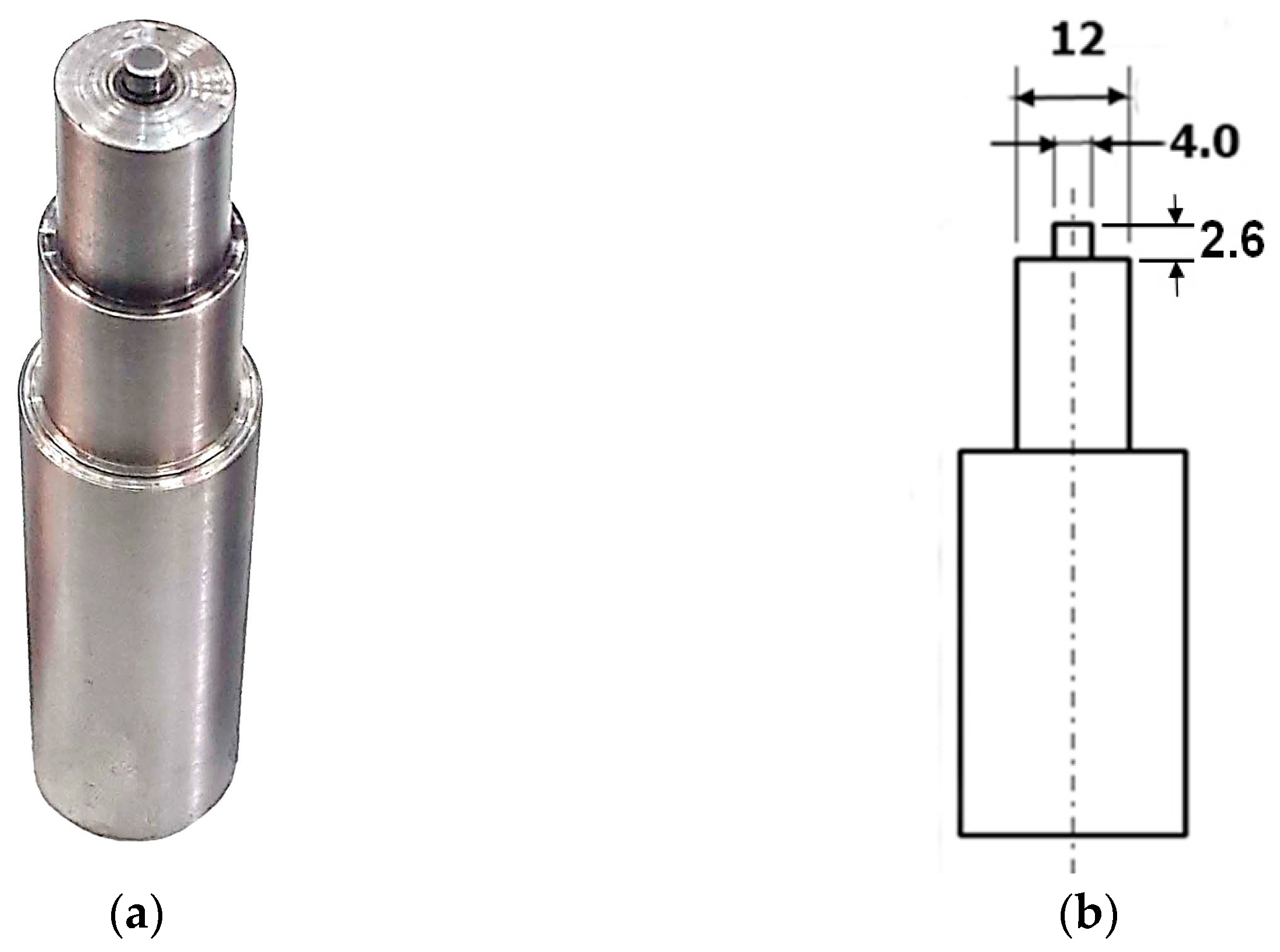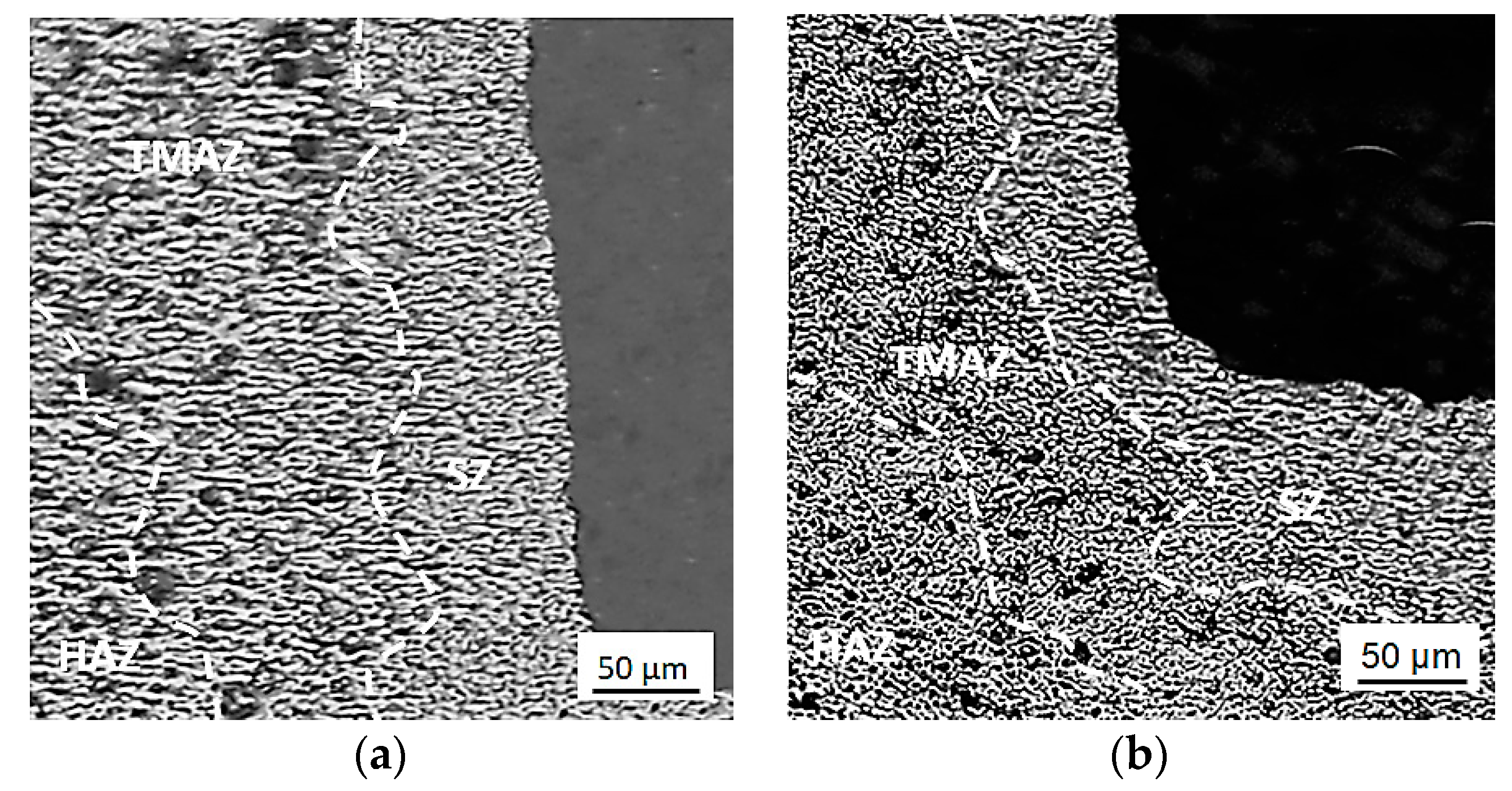Effect of Tool Rotational Speed and Dwell Time on the Joint Strength of Friction Stir Spot Welded AA6061-T6 Sheets †
Abstract
:1. Introduction
2. Materials and Methods
3. Results and Discussion
3.1. Microstructure
3.2. Tensile Test
3.3. Micro-Hardness
4. Conclusions
Author Contributions
Funding
Institutional Review Board Statement
Informed Consent Statement
Data Availability Statement
Conflicts of Interest
References
- Alkhafaji, A.; Camas, D.; Lopez-Crespo, P.; Al-Asadi, H. The Influence of Tool Geometry on the Mechanical Properties and the Microstructure of AA6061-T6 Aluminum Alloy Friction Stir Spot Welding. Materials 2023, 16, 4135. [Google Scholar] [CrossRef] [PubMed]
- Mubiayi, M.P.; Akinlabi, E.T. Friction stir spot welding between copper and aluminium: Microstructural evolution. In Proceedings of the International MultiConference of Engineers and Computer Scientists 2015, Hong Kong, China, 18–20 March 2015; Volume 2, pp. 18–20. [Google Scholar]
- Jambhale, S.; Kumar, S.; Kumar, S. Effect of process parameters & tool geometries on properties of friction stir spot welds: A review. Univers. J. Eng. Sci. 2015, 3, 6–11. [Google Scholar]
- Shen, Z.; Yang, X.; Zhang, Z.; Cui, L.; Yin, Y. Mechanical properties and failure mechanisms of friction stir spot welds of AA 6061-T4 sheets. Mater. Des. 2013, 49, 181–191. [Google Scholar] [CrossRef]
- Song, X.; Ke, L.; Xing, L.; Liu, F.; Huang, C. Effect of plunge speeds on hook geometries and mechanical properties in friction stir spot welding of A6061-T6 sheets. Int. J. Adv. Manuf. Technol. 2014, 71, 2003–2010. [Google Scholar] [CrossRef]
- Sathyaseelan, P.; Manickavasagam, V.M.; Ravichandran, P.; Prasad, D.V.S.S.S.V.; Ramana Murty Naidu, S.C.V.; Pradeep Kumar, S.; Khan, A.A.; Karthik, R.; Kerga, G.A. Effect of Dwell Time on Fracture Load of Friction Stir Spot Welded Dissimilar Metal Joints. Adv. Mater. Sci. Eng. 2022, 2022, 2163507. [Google Scholar] [CrossRef]
- Rojikin, S.; Muhayat, N.; Triyono. Effect of rotation speed on mechanical properties and microstructure of friction stir spot welding (FSSW) Al 5052-Steel SS400. In IOP Conference Series: Materials Science and Engineering; IOP Publishing: Bristol, UK, 2018; Volume 420, p. 012023. [Google Scholar]
- Ugla, A.A.; Al-Roubaiy, A.O.; Alazawi, F.H. Effect of Dwell Time and Tool Rotational Speed of Friction Stir Spot Welding on the characteristics of AA3105 joints. Univ. Thi-Qar J. Eng. Sci. 2018, 9, 51–58. [Google Scholar] [CrossRef] [PubMed]
- Nasir, T.; Kalaf, O.; Asmael, M. Effect of rotational speed, and dwell time on the mechanical properties and microstructure of dissimilar AA5754 and AA7075-T651 aluminum sheet alloys by friction stir spot welding. Mater. Sci. 2021, 27, 308–312. [Google Scholar] [CrossRef]






| Variant | Value |
|---|---|
| Tool rotational speed (rpm) | 426, 710, 960, 1400 |
| Dwell time (s) | 10, 15 |
| Plunge depth (mm) | 0.3 |
| Plunge rate (mm/min) | 10 |
Disclaimer/Publisher’s Note: The statements, opinions and data contained in all publications are solely those of the individual author(s) and contributor(s) and not of MDPI and/or the editor(s). MDPI and/or the editor(s) disclaim responsibility for any injury to people or property resulting from any ideas, methods, instructions or products referred to in the content. |
© 2023 by the authors. Licensee MDPI, Basel, Switzerland. This article is an open access article distributed under the terms and conditions of the Creative Commons Attribution (CC BY) license (https://creativecommons.org/licenses/by/4.0/).
Share and Cite
Alkhafaji, A.; Camas, D. Effect of Tool Rotational Speed and Dwell Time on the Joint Strength of Friction Stir Spot Welded AA6061-T6 Sheets. Eng. Proc. 2023, 56, 215. https://doi.org/10.3390/ASEC2023-15229
Alkhafaji A, Camas D. Effect of Tool Rotational Speed and Dwell Time on the Joint Strength of Friction Stir Spot Welded AA6061-T6 Sheets. Engineering Proceedings. 2023; 56(1):215. https://doi.org/10.3390/ASEC2023-15229
Chicago/Turabian StyleAlkhafaji, Amir, and Daniel Camas. 2023. "Effect of Tool Rotational Speed and Dwell Time on the Joint Strength of Friction Stir Spot Welded AA6061-T6 Sheets" Engineering Proceedings 56, no. 1: 215. https://doi.org/10.3390/ASEC2023-15229
APA StyleAlkhafaji, A., & Camas, D. (2023). Effect of Tool Rotational Speed and Dwell Time on the Joint Strength of Friction Stir Spot Welded AA6061-T6 Sheets. Engineering Proceedings, 56(1), 215. https://doi.org/10.3390/ASEC2023-15229







